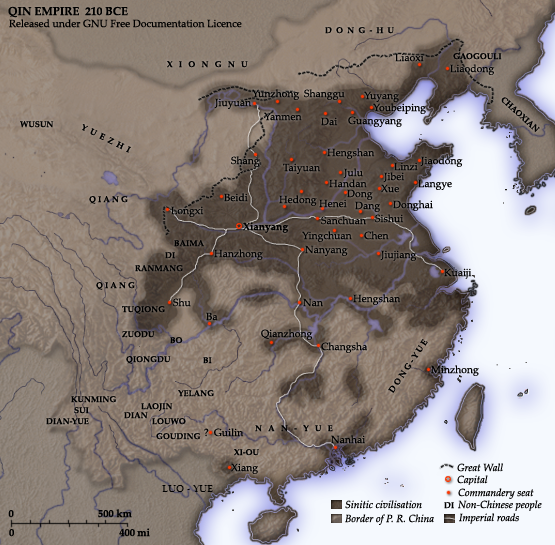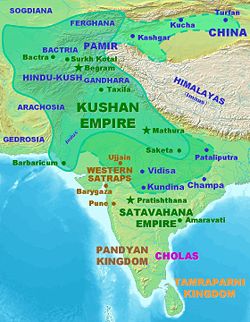Emperor Wudi did send out an expedition. Why and who was he trying to contact?
The answers to those questions will make it clear that the area now called the Xinjiang Province of China was not settled (then) by the same people as Emperor WuDi ruled over.
That means that the claim,
Her very existence, and that of others that have been found in China’s Tarim Basin, in Xinjiang province suggest that the area was settle by Europeans rather than Asians initially. That flies in the face of the accepted history of China.
shows that the author of the statement knows nothing about the history of the area, or the people that lived there.
Here's a map of what we now call China at the end of the short lived Qin dynasty and beginning of the Han dynasty. That's about 210BCE.

When the first Emperor of the Qin dynasty died, the elite families under the leadership of the Han rebelled, defeated the first Emperor's son and established a new dynasty, the Han.
During both dynasties, the biggest fights were with the Xiongnu, whose territory was (as shown at the top of the map) up in the north on the steppe lands.
You can note that to the west of the Qin empire's western boundary, there were another people, the Yuezhi, who were also in a state of perpetual warfare with the Xiongnu.
Wudi (who ruled between 140BCE and 87 BCE) decided to attempt to form an alliance with the Yuezhi in a bid to finally defeat the Xiongnu. So that tells you who was living in roughly the same area as modern Xinjiang.
Wudi's emissary Zhang Qian volunteered for that expedition little knowing that it would be years before he would be able to get back to China.
In summary, he found that the Yuezhi had decided to move on further to the west, where they formed the Kushan Empire.
This map shows their later territory, which again demonstrates how complex the ethnic origins of people in Central Asia can be. Today, the political divisions include Afghanistan, (and parts of the other 'stans.') Pakistan and India.

Here's how a Wikipedia entry tells their story:
The Kushan Empire (Bactrian: κυϸανο ; Sanskrit: कुषाण राजवंश Kuṣāṇ Rājavaṃśa; BHS: Guṣāṇa-vaṃśa; Parthian: 𐭊𐭅𐭔𐭍 𐭇𐭔𐭕𐭓 Kušan-xšaθr [4] ) was an empire in South Asia originally formed in the early 1st century CE underKujula Kadphises in the territories of ancient Bactria around the Oxus River (Amu Darya), and later based nearKabul, Afghanistan. [5] The Kushans spread from the Kabul River Valley to defeat other Central Asian tribes that had previously conquered parts of the northern central Iranian Plateau once ruled by the Parthians, and reached their peak under the Buddhist emperor Kanishka (127–151), whose realm stretched from Turfan in the Tarim Basin toPataliputra on the Gangetic Plain." [3]
The Kushans were one of five branches of the Yuezhi confederation, [6] [7] a possibly Iranian [8] or Tocharian, [9] Indo-European [10] nomadic people who had migrated from the Tarim Basin and settled in ancient Bactria. [7] Some of the Kushan kings, amongst which Kanishka, had a Turushka origin. [2] [11] During the 1st and early 2nd centuries CE, the Kushans expanded across the northern parts of the Indian subcontinent at least as far as Saketa and Sarnath nearVaranasi (Benares), where inscriptions have been found dating to the era of the Kushan emperor Kanishka, which began about 127 CE [12] [13] [14] Around 152 CE, Kanishka sent his armies north of the Karakoram mountains. They captured territories as far as Kashgar, Khotan and Yarkant, in the Tarim Basin of modern-day Xinjiang, China. A direct road from Gandhara to China was opened which remained under Kushan control for more than 100 years. The security offered by the Kushans encouraged travel across the Khunjerab Pass and facilitated the spread of Mahayana Buddhism to China.
The Kushan dynasty had diplomatic contacts with the Roman Empire, Sassanid Persia, Aksumite Empire and Han China. While much philosophy, art, and science was created within its borders, the only textual record we have of the empire's history today comes from inscriptions and accounts in other languages, particularly Chinese. [15] The Kushan control fragmented into semi-independent kingdoms in the 3rd century CE, which fell to the Sassanians who targeted from the west. In the fourth century, the Guptas, an Indian dynasty also pressed from the east. The last of the Kushan and Sassanian kingdoms were eventually overwhelmed by the Hepthalites, another Indo-European people from the north. [3]
(I've left the links alive (if they stay that way) so that anyone who wants to can follow through on the story).
Wiki reference: http://en.wikipedia.org/wiki/Kushan_Empire



